2005 VOLKSWAGEN GOLF stop start
[x] Cancel search: stop startPage 15 of 444
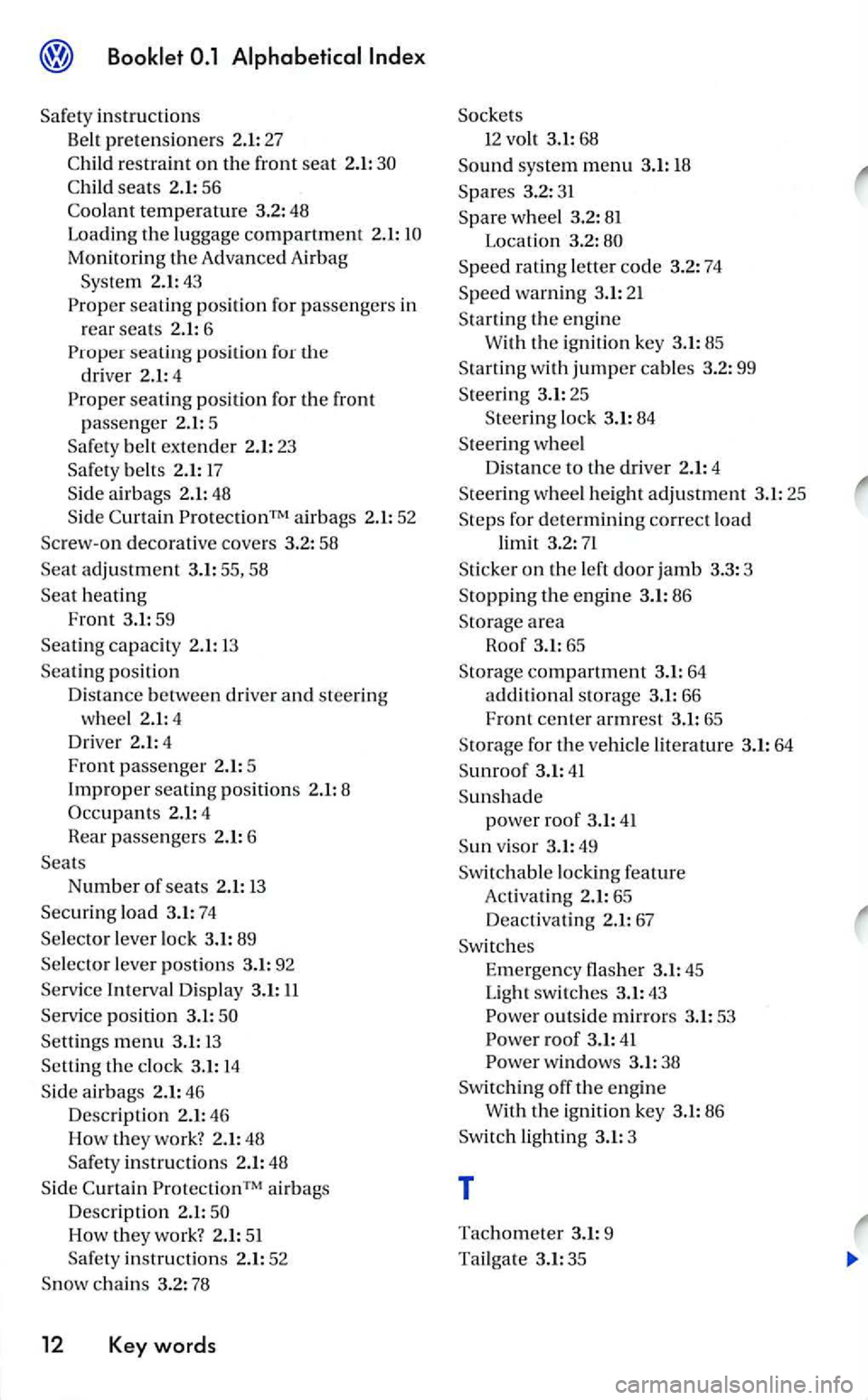
Safety instructions
Belt pretensioners 2.1: 27
Child restraint on the front seat 2.1:
Child seats 2.1 : 56
Coolant tempera ture 3.2:48
Loading
the lu ggage compartment 2.1:
seating position for passengers in
r
ear seat s 2.1: 6 seating position for
driver 2.1: 4
seating position for the front
passenger 2.1: 5
Safety belt extender 2.1: 23
Sa fet y
belts 2.1: 17 S id e airbag s 2.1: 48
Side Curtain ProtectionTM airbags 2.1: 52
Screw-on decorati ve covers 3.2: 58
Seat adjustment 3.1: 55, 58
Seat heating
Front 3.1:
59
Seating ca pacity 2.1: 13
Sea ting
position
Di s
tance between driver and ste erin g
w
hee l 2.1:4 Dr iver 2.1: 4
Fron t passen ger 2.1: 5 Improper seatin g position s 2.1: 8
Speed rating le tter code 3.2: 74
Speed warning 3.1: 21
Starting th e engine W ith the ig nition key 3.1:85
S tartin g
with jumper cables 3.2: 99
Stee rin g 3.1: 25
S
teering lock 3.1: 84
S te ering
wheel
Di s
tance to the driver 2.1: 4
Steerin g wheel height adjustment 3.1: 25
S
teps for determining co rrect load limit 3.2: 71
Sticker on th e left door jamb 3.3 : 3
Stopping the en gine 3.1:8 6
Sto rage
area
Roof 3.1:65
S torage
compartment 3.1: 64
additional sto rage 3.1: 66
Front center armrest 3.1: 65
S torage for
the vehicle literature 3.1: 64
Sunroof 3.1: 41
Sunshade
power roof 3.1:41
Sun viso r 3.1:49
Sw itch
able loc king feature
Activatin g 2.1: 65
D
eacti va tin g 2.1: 67
Sw itches Em ergency flasher 3.1: 45
Light swit ches 3.1: 43 outside mirrors 3.1: 53 ro of 3.1:41 windows 3.1: 38
Sw itching off the engin e
W ith the ignit ion key 3.1: 86
Sw itch
lig htin g 3.1: 3
T
Tachometer 3.1: 9
Ta
ilga te 3.1:35
Page 171 of 444
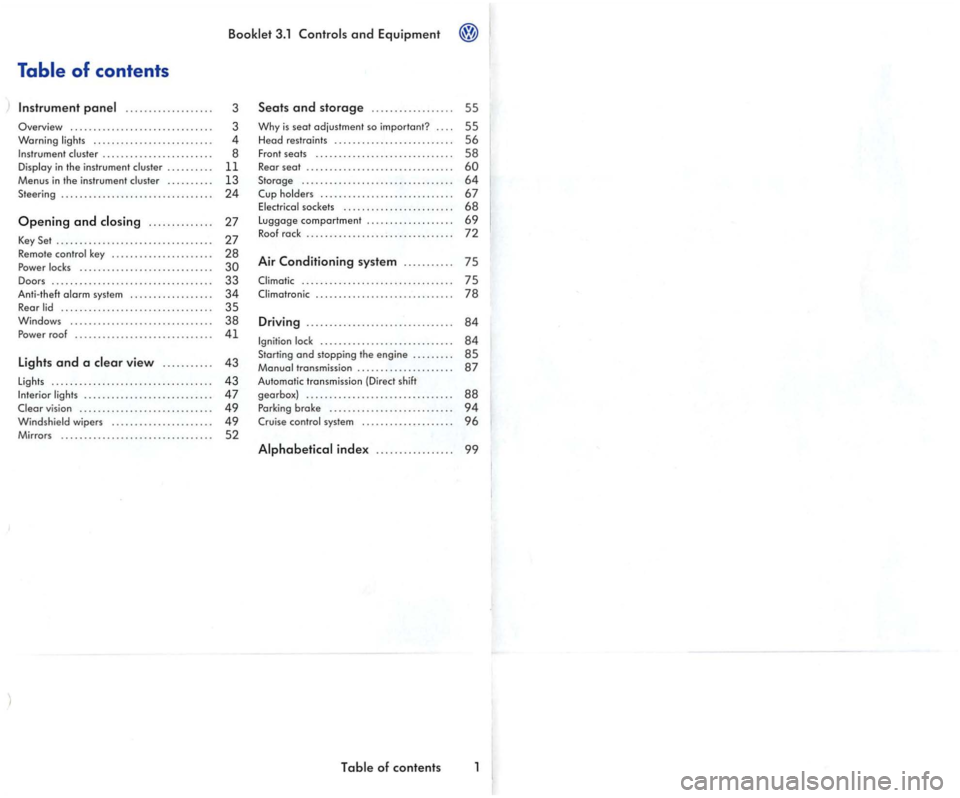
Table of contents
.................. .
Overview .......................... o
Warning ..
.............. ......... . in the instrument ..... o
Menus in the in strum ent
Opening and .... o o
Key Set ........................ o o
Remote
Power ........................ o
Doors ... ...................... o Anti-theft sys tem ............. Rear .......................
Windows ............... .. . Power roof ........
Lights and a view .......... .
Ligh ts ........................... .......
vision .............. o
Mirrors ............................
3ol and Equipm ent
3
3
4
8
11
13 24
27
27
28
30
33
34
35 38 41
43
43
47
49
49 52
Seats and storage ............. .... .
Why is seat adjustment so important? ... .
He
ad re straints .......... ............... .
Fro
nt seats ............................. . Rear seat .................. ............. .
Storage ................................ .
Cup .................. o soc kets ........ o o
Luggage comportment .................. .
Roof rock .....................
Air Conditioning system .......... .
........................ o
Driving ........... o .................
........................... .. Starting and stopping the en gin e ........ . transmission .................... .
Auto matic transmission
(Direct shift
gearbox} ............................... .
Parking
broke ................ ... .
Crui se system ................... .
55
55
56
58
60 64
67 68
6 9
72
75
75
78
84
84
85 87
88 94
96
of contents
Page 212 of 444
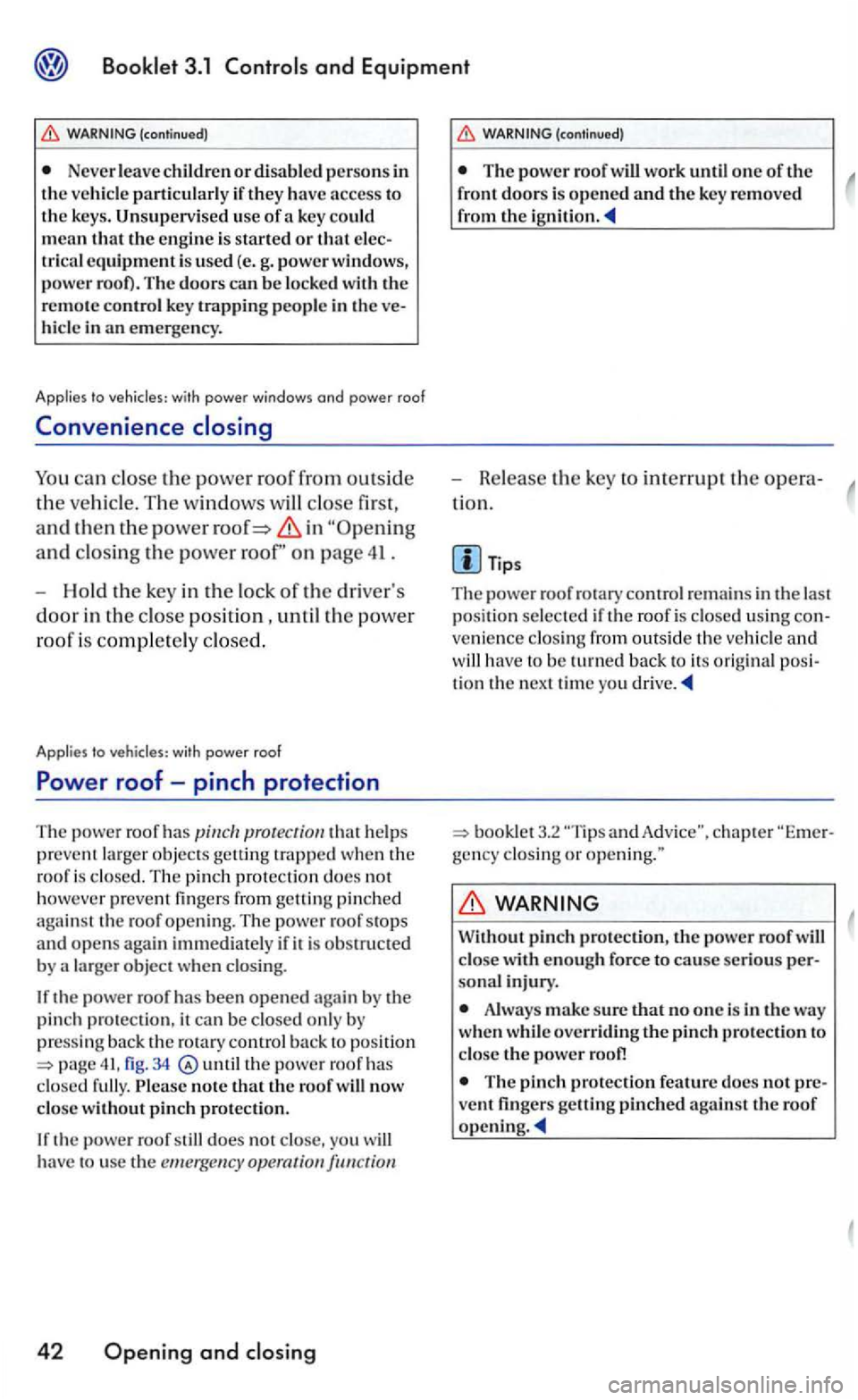
(continued)
Never or if they have access to
the keys. Unsupervi sed u se of a ke y mean that the engine is starte d or that equipment is use d (e. g. pow er windows,
pow er root) . The doors can be with the remote in the vein an emergency .
lo with power windows ond power roof
Convenience
ca n clo se the powe r roof from outs id e
the vehicle. The windows will close first,
a
nd then th e power in
to with power roof
Power roof -pinch protection
The power roof has protection that prevent The pinch prote ction does not
h oweve r prevent fingers from gettin g pinched
agai nst th e roof openin g. The power roof stop s
and open s aga in if it is obstru cted by lar ger object when
the power roof has been opened again by the pin ch pro tection, it ca n be pressing back the ro ta ry cont rol back t o posit ion fig. 34 the power roof has note that
the pow er roof still does not you hav e to use the emergency operation
42 Opening and
The power roof wiU work o ne of the front doors is opened and the key removed
fr om the
- Release the key to interrupt the opera
tion.
i f the roof is using convenience have to be back to its posi
t ion the next time you
3.2 and chapt er
WARNING
Without pinch protection, th e power roof with enou gh f orc e to cause serio us per
make sure over ridin g pinch protection to
Th e pi nch protec tion feature doe s not prevent
Page 256 of 444
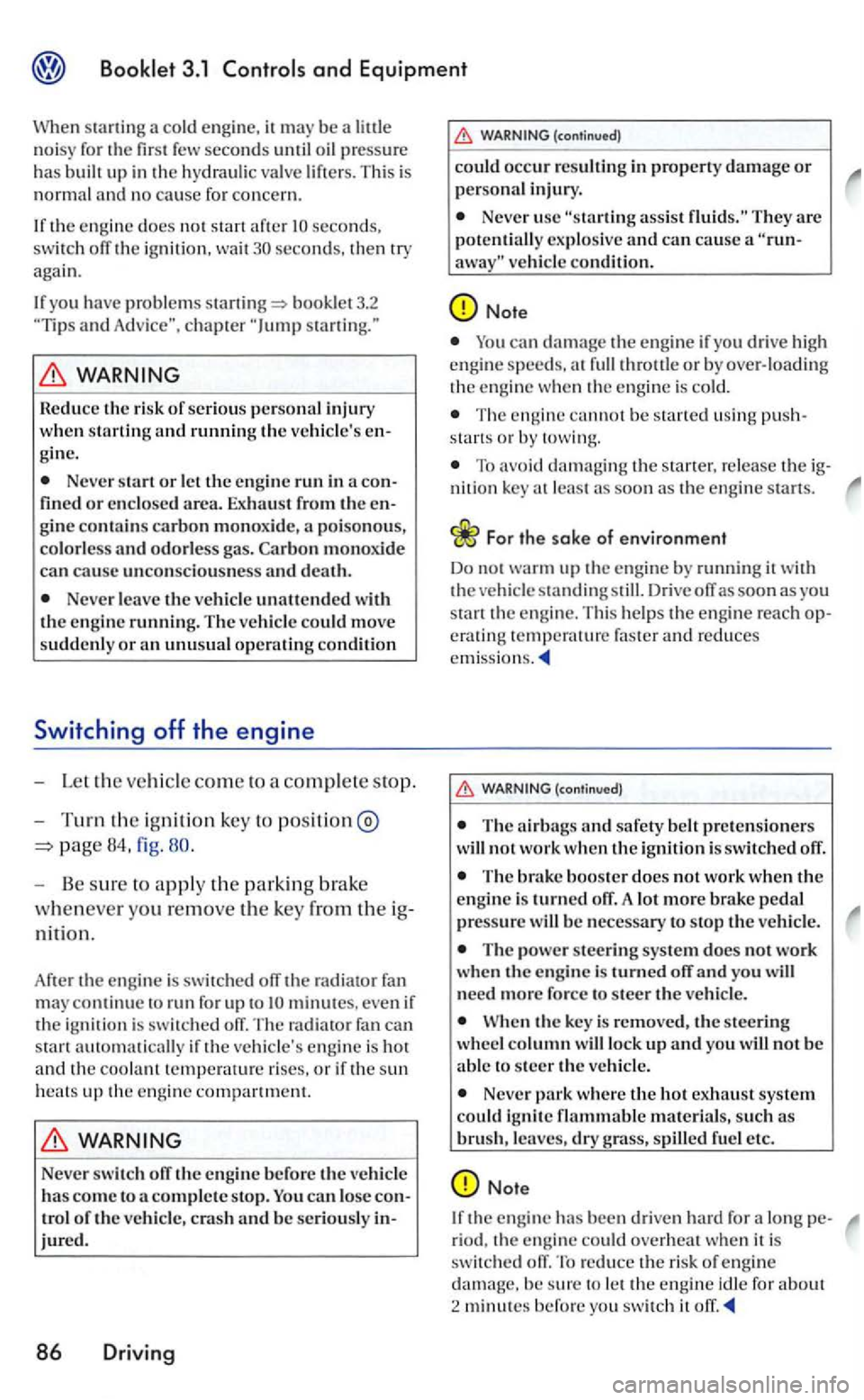
and Equipment
sta rtin g a co ld engin e, it may be a little
n o isy for the first few seconds until oil pressure has built up i n the hydraulic va lve lift ers . T his is normal and n o cause for concern.
I f
the engine does no t sta rt after seconds. switch off the ig niti on, wait seconds, then try
again.
I f yo u
have problem s booklet 3.2 and ch apter
g in e.
Never sta rt or le t the e ng in e run in fin ed or e n closed area. Exhaust from the poi so no us,
co lorless and odorless gas. Carbon can cause unco nsciou sness and death.
Never leave the ve hicl e unatt ended wit h the eng in e runnin g. The vehi cle could move
suddenly or an unus u a l o pe ra tin g condition
Switching off the engine
-Let the vehicle com e to a comple te sto p.
- T
urn th e ig nit ion key to pos iti on @
- Be sure to apply the par k in g brake
w he neve r yo u r
emove the key from the
nition.
Af te r the en gi ne is switched off the rad iator fan
m ay cont inu e to run for up co
Never sw itch off the engine before the vehicle
has com e to a complete stop. can lose tro l of the vehicle , crash and be seriou sly jured.
86 Driving
Neve r u sc "startin g assist fluid s." They are potentially explo sive and can cause a ve hicle cond it ion.
Note
can damage the engin e if you d rive hig h
e ngin e speeds, at full thro ttle or by over- loading
t h e e ngi ne whe n the engine is cold.
T he cann ot be sta rt ed usin g
To avoid the sta rt er, re lease the nition key as soon as the engin e starts.
For the sake of environment
Do not warmup the engine by running it w ith the ve hicle standing s till. Drive off as soon as yo u
s tart the engine. This help s the e ngine reac h
WARN ING (continued )
The airbag s and sa fety belt prc te n si one rs
will not work w hen th e ig n itio n is s wit ch ed off.
The brake booster does not wo rk w hen th e
engi ne is turned off. A lo t more brake pedal press ure will be necessa ry to sto p the vehicle.
T he power steering syste m does not work
whe n the eng in e is turned o ff and you w ill
need m ore force to s teer the vehicl e.
the ke y is remove d , the steerin g
wheel column will lock up and you will not be able to s teer th e ve hicle.
Neve r park whe re th e hot exhaust system could ignite flammable mate ria ls, su ch as brus h , leaves, dry grass, spilled fue l e tc.
Note
If the engine has been dri ven hard for a lo ng riod, th e engine co uld over hea t when it is
switched off. To reduce th e risk of eng ine damage. be sure co Ieee h e e ng in e idl e for about
2 min ute s befo re yo u sw itch it
Page 257 of 444
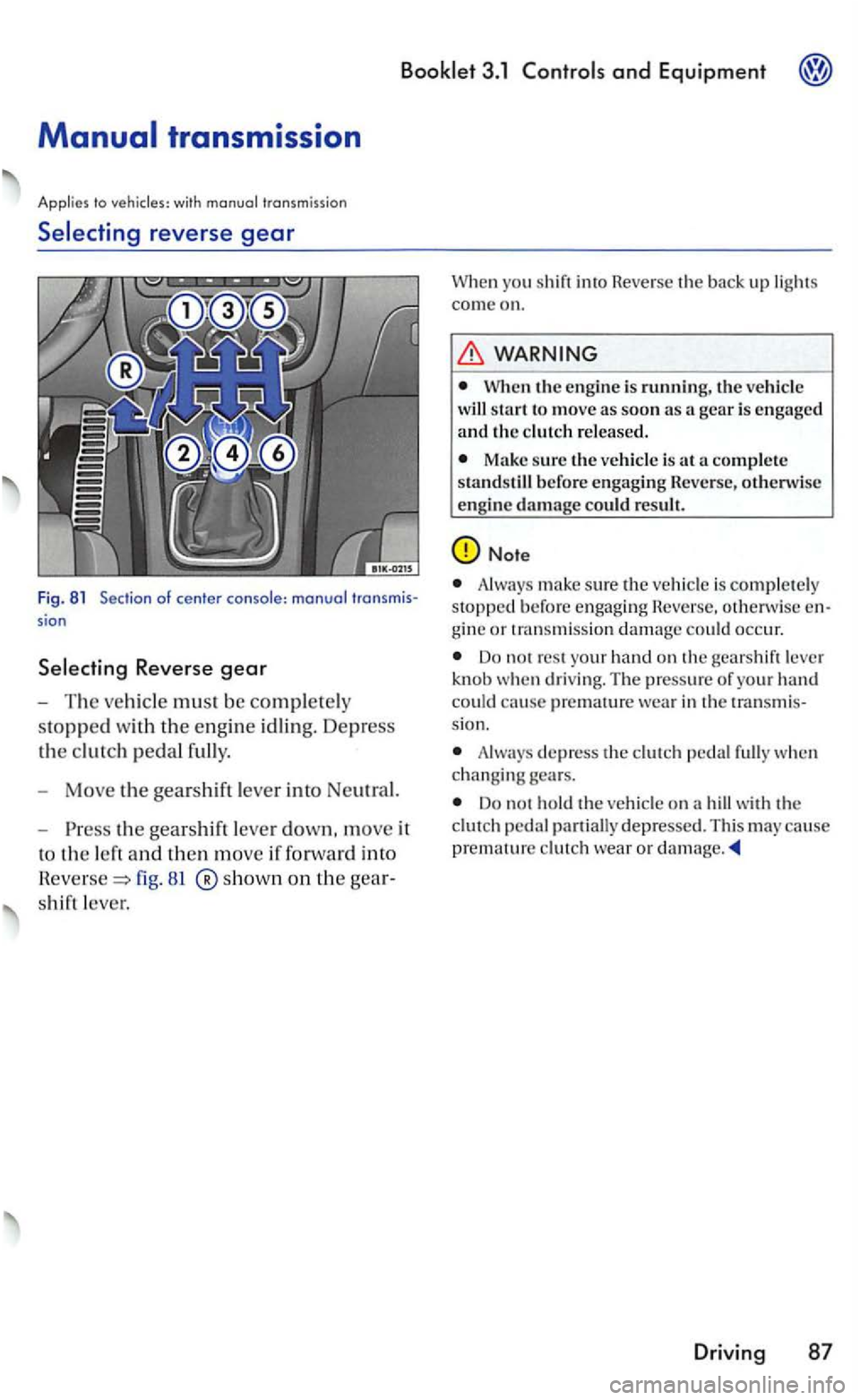
3.1 and Equipment
with
Selecting reverse gear
Fig . 81 Section of center sion
81 ®show n on th e
shift leve r.
you shif t in to Rever se th e bac k up lights
c om e on.
WARNING
When the e ngine is run n in g, t he start t o m ove as soo n as a gear is e ngaged
a nd the
Make sure the ve hicl e is at a comple te
s tandstil l b efor e engagin g Rev ers e, oth erw is e
e ng in e da mage c oul d re sult .
Always make sure the is com ple te ly stopped befo re e ngaging Reverse. othen vise
Do n o t res t your ha nd on the gears h ift leve r
knob when dri ving. The press ure of your hand
could ca use premat ure wea r in th e transmis
s ion.
Always dep ress the ped al full y w hen ch anging gears.
Do not hold the on a hill with t he peda l part ially depresse d. T his may cause
p remature clu tch wea r o r damage .
Drivi ng 87
Page 261 of 444
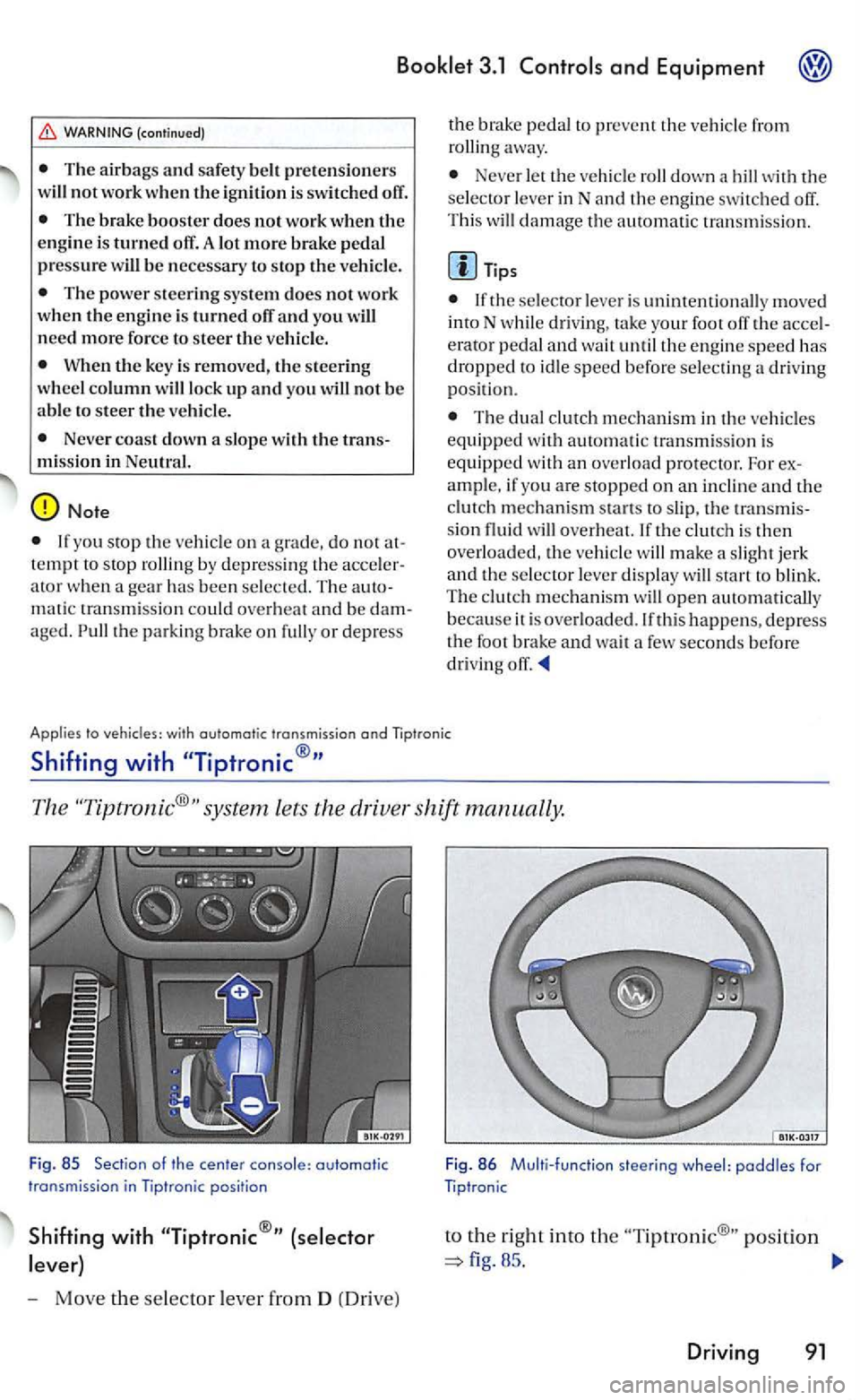
3.1
WARNING (continued)
T he air bags and safe ty be lt pre te n sio ners
will not work w he n the ign ition is switch ed off.
Th e brake booster does not work when the e ngine is turned off. A lot more brak e pedal pressu re w ill be necessary to stop the vehicle.
The power steering syste m does not work
w hen the e ngine is turned off and you will need more force to steer the ve hicl e.
When the key is removed, the s teering wheel column will lock up a n d yo u will not be able to steer the veh icle.
Neve r coast down a s lope with the tran smission in Neutral.
Note
If you stop th e ve hicle on a grade , d o not attempt to stop rolling by depres sin g th e acce le rator w hen a gea r has been se le ct ed. The automatic tra nsmi ssion could overhea t and be dam
a ge d. Pull the parkin g brake on full y or depress t
h e
brake ped al to prevent th e ve hicle from
ro llin g away.
Neve r le t the ve hicl e roll down a hill with the se lector le ver inN and the engine swit ched off .
Thi s will damage the automatic tran smission.
Tip s
lfthe sele cto r le ver is un int en tio nally m oved
int o N while driving , take your foot off the accel
era to r pedal and wa it until the engin e speed has dropped to idle sp eed b efore selec tin g a driv ing position.
The dual clut ch mechanism in the vehicl es
e quipped with au tomatic tra nsmis s io n is
equip ped with an overload pro tector. For ex
ample, if yo u are stopped on a n inclin e and the
clutch mechanis m sta rts to slip, th e transmi s
s ion fluid will ove rheat. th e clutch is then overload ed, the vehicle will m ake a slight jerk and th e s elector leve r d is play will start to blink.
T he clut ch m echanism will op en auto mati cally
because it i s o verloaded .lf th is happe n s, d epress the foot brake and wait a few se conds before
dri ving off.
Applies lo veh icles: w ith automol ic tr ansmission and
Shifting with
The system lets th e driver shift manually.
Fig. 85 of
- Move the sele c tor leve r from D (Dr iv e)
F ig . 86 Multi-function steering wheel: paddles for
to the right into the po sition
85 .
Driving 91
Page 293 of 444
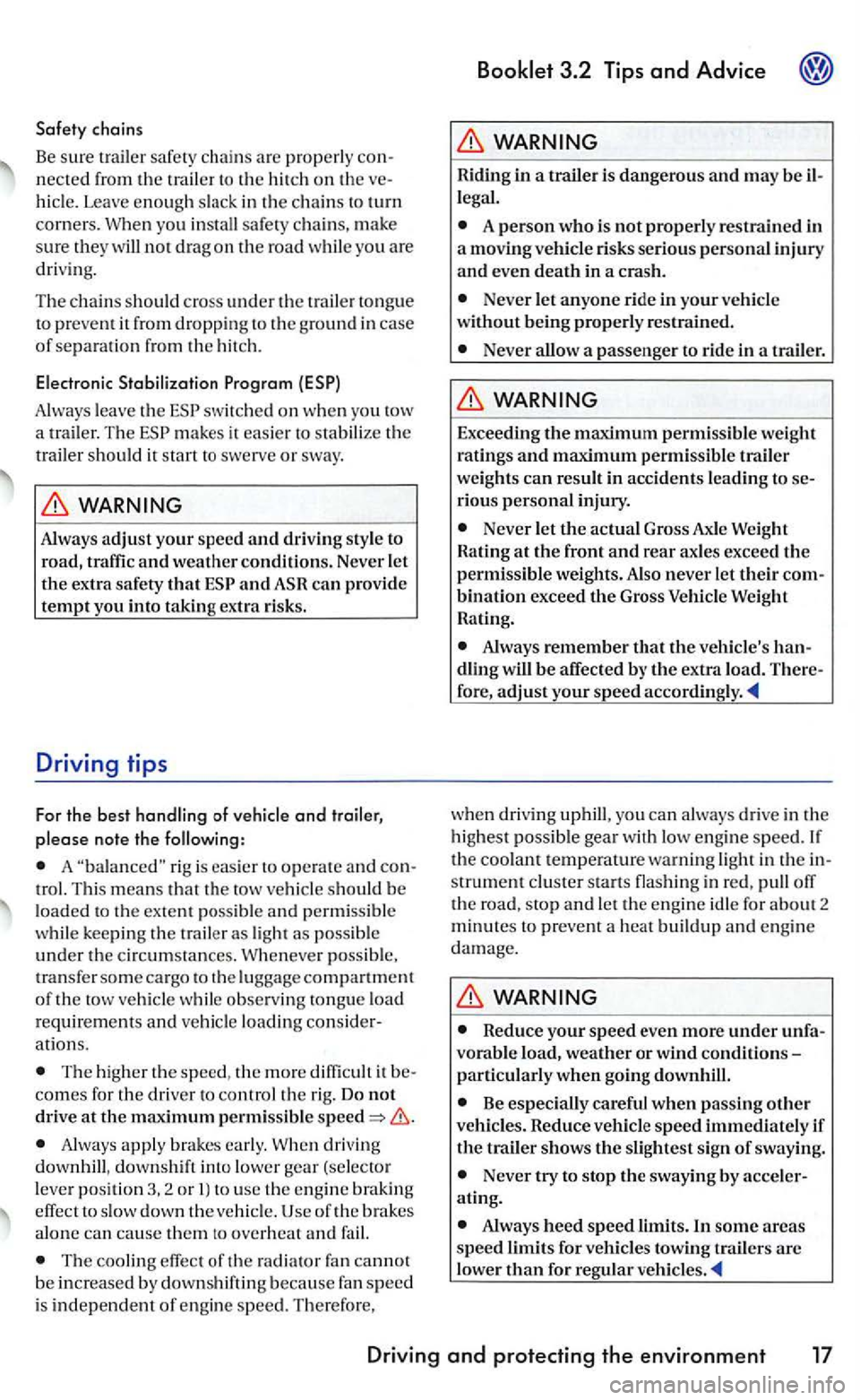
Safety chains
Be sure trailer safe ty cha ins are prop erly necte d fro m the trailer to th e hitch on th e hicle. Leave enoug h slack in th e c hain s to turn
corners. When you install safety ch a in s, mak e sure they will not dragon th e road whi le you are
driv ing.
Th e chains shou ld c ross
under th e trai le r to ng ue
to prevent it from dropping to the ground in case of separa tion from the hit ch .
Electronic Stabilization
Always leave th e mak es it easie r to stabilize the
t railer sho uld it start to swerve or sway.
Always adjust your speed and driving style to
road, traffic and weather conditions. Never le t the extra safety that and
A rig is eas ier to o pe rate and trol. Thi s means that th e tow vehicle should be loaded to the exte nt possibl e and permi ssibl e
w hil e keepin g th e t raile r as lig ht as possibl e under the ci rcumstances . Whenever possible, tran sfe r so me cargo to the luggage compartm ent
o f th e tow vehicle whil e observ ing tongue load requireme nts and ve hicl e loading ation s.
The hig her th e spee d, the more diffi cult it comes for the driver to control the rig. Do not drive at the maximum permissible
Always appl y brake s early . W hen dri ving
downhill , down shift into lower gear (selector leve r positi on
The cooli ng effect of th e fa n cannot
b e in cre ase d by dow nshif tin g because fan speed
i s independent of engine speed. Therefore,
Riding in a trailer is dangerous and may be
A person who is not properly restrained in
a moving vehicle risks serious personal injury and even death in a crash.
Never let anyone ride in your vehicle
without being properly restrained .
Never allow a passenger to rid e in a trailer.
Exceed ing the maximum permissible weight ratings and maximum permissibl e trailer
weights can result in accident s leading to rious personal injury.
Never le t the actual Gross Axle W eight Rating at the front and rear axles exceed the
permissible weights. Also never let their bination exceed the Gross Weight
Rating.
Always remember that the vehicle's
w he n dri vin g uphill, you can alwa ys drive in the
hi ghes t possibl e gear wit h low engin e speed. the coo lant tempe rature warni ng light in th e strument clu ster start s flas hin g in red, pull off
th e ro ad, s top and let th e engine idle for ab o ut 2 minutes to preve nt a heat buildup and eng in e
damage.
R educe your speed even more under vorab le load , weather or wind conditions
particularly when going downhill.
Be especial ly careful when passing other vehicles. Reduce vehicle speed immediately if the trail er shows the slightest sign of sway ing.
N ev e r try to stop the sway ing by ating.
Always heed speed limits.ln some a reas speed limits for vehicle s towing
Driving and protecting the environment 17
Page 294 of 444
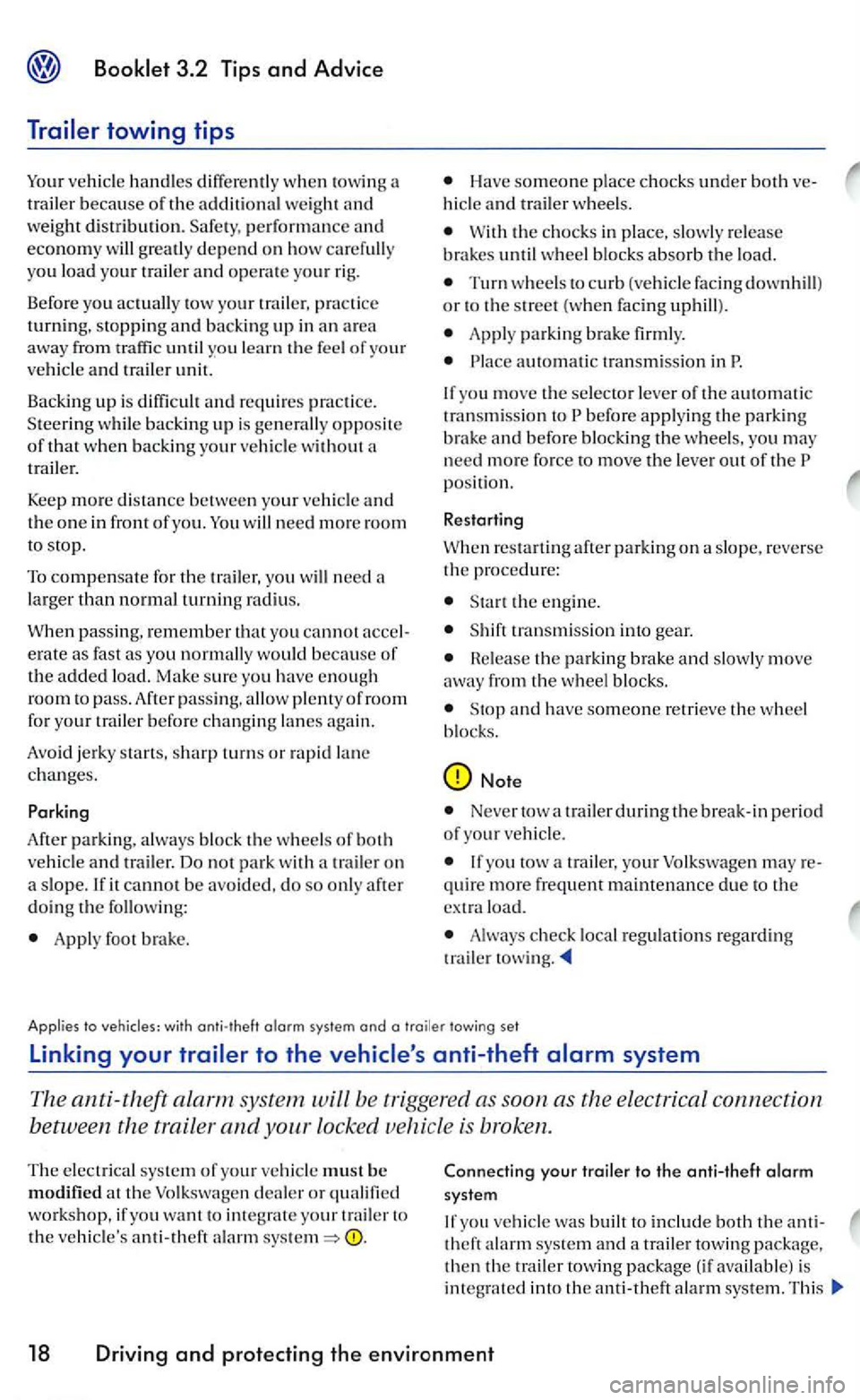
Booklet 3.2 Tip s and Advice
vehicl e handles diff ere ntl y wh en towin g a
tr ai ler because of the additional weigh t and weight distribution. Safe ty, pe rform ance and econo m y will greatl y depend on how carefull y
yo u load your trailer and op erat e your rig.
Before you actually to w your trail er, p ractic e
turning. stopping and b ack ing up in an area away from traffic until learn the feel of your vehicle and trail er unit.
Backing
up i s diffi cult and requi res practi ce.
Stee rin g whil e backing up is gen erall y opposite of that when backin g your vehicl e with out a
trailer.
Keep
more distance between your vehicl e and the one in front of yo u. will need more room to stop.
To compensate for the trail er. you will need a
larger than normal turning radius.
When passing, remember that you cannot erate as fast as you normally would because of the added load. Make sure yo u have enough
room to pass. After passing. allow plenty of room for you r trailer before c hanging lanes again.
Avoid je rk y s tart s, sharp turn s or rapid lan e changes.
Parking
After parking. always block th e wheels of both ve hicl e and trail er. Do not park with a traile r on a slope. If it cannot be a voided, do so only after doing th e follo wing:
Apply fo ot brake .
Have someone place chocks under both hicl e and trail er whee ls .
With the c hock s in place, s lo w ly re lease brak es until wheel blo cks absorb the load.
Turn w heels to curb (ve hicl e facing downhill)
o r to the stre et (when facing uphill).
Appl y parkin g brak e firmly.
automatic transmi ssion in
If you move the selecto r leve r of the automatic tran smission to
position.
Restarting
When restarting after parkin g on a slop e, reverse
the proc edure:
S tart the engine.
S hift transmission into gear.
le a se the parking brake and slowly move away from the wheel block s.
Stop and hav e someone re trie ve the wheel
b lock s.
Note
Neve r to w trailer during the break-in period of your vehicl e.
If yo u tow a trailer , yo ur Volksw age n m ay quire more frequent maimenance due to the
ext ra load.
Always check local reg ulations regardi ng
trailer to w in g.
Applies to vehicles: with anti-theft a larm system and a traile r towing set
Linking your trailer to the vehicle's anti-theft alarm system
The anti-theft alarm syste m will be triggere d as soon as the ele ctrical connec tion
between the trailer
and
or qualified
wo rkshop, if you want to inte grat e your trai le r to th e ve hicle's anti-theft a larm
Connecting your trailer to the anti-theft alarm syste m
If yo u ve hicle was built to include both the th eft al arm system and a trailer towin g th en t he trail er towing package (if available) is
in tegrated into the anti-theft alarm sys te m . Thi s
18 Driving and protecting the environment